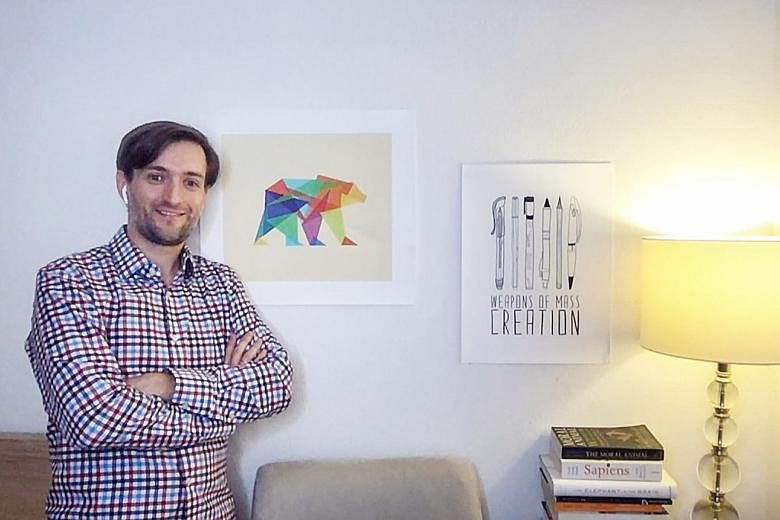Back in early March in San Francisco, Tomas Pueyo's wife was warded in hospital for three days for suspected Covid-19.
Left at home with their three young children and feeling sick himself, the French-Spanish engineer decided to write an article about how the coronavirus was spreading throughout the world.
His March 10 analysis on the Medium blogging platform was titled Coronavirus: Why You Must Act Now.
Packed with charts and data, it was a long, 27-minute read, but compelling in its clarity and detail.
Mr Pueyo's bottom line was this: The coronavirus is spreading at exponential speed and will come gradually, then suddenly.
Healthcare systems will be overwhelmed and people will die. The only way to prevent this is for government, community and business leaders to implement immediate social distancing and keep as many people home as possible.
His piece went viral. At last count, the article has been viewed over 40 million times and translated into more than 40 languages.
Ten days later, the 37-year-old followed up with another long essay called Coronavirus: The Hammer And The Dance.
In it, he urged governments to adopt strict measures ("the hammer") such as lockdowns for a few weeks, to buy time to come up with a plan to control the virus until there is a vaccine.
Once out of lockdown, countries can enter a new phase ("the dance") where life resumes but with measures like a ban on large gatherings and a focus on contact tracing, testing, isolating and quarantining Covid-19 cases.
This article has been read more than 15 million times since, with politicians and epidemiologists alike referring to his hammer and dance strategy.
His ability to make sense of data and write in a lucid manner has made him an influential voice on the pandemic.

At the time of writing his first piece on March 10, the global tally was 117,000 people with Covid-19 and 4,400 deaths.
As of last Friday, when I met Mr Pueyo over Skype, more than 8.3 million people around the world have had Covid-19, and more than 450,000 have died.
His articles were prescient.
HAMMER AND DANCE
He had suggested we dial in at 9.30pm his time, which would be 12.30pm Singapore time, "which could actually be your lunchtime", he says in an e-mail, adding a smiley face.
I reply that we could also do it earlier if he likes, so he can have dinner while we talk.
"My dinner time is blocked by the kids (4, 4 and 2!) but I can eat some dessert :)," comes the reply.
We settle for 9.30pm his time.

This is my first virtual lunch, and I'm doing it at The Straits Times studio in News Centre. I bring along a juice and a Saladstop! grain bowl I had had delivered to the office.
The video producer had arranged for a sound check 10 minutes before the interview, but Mr Pueyo is not answering his call.
By 9.45pm, I'm starting to worry that he has forgotten about our date. He comes online soon after, apologising several times. I don't think he has brought along dessert.
I ask if his children are asleep.
"Yeah, I finally put them to bed," he says, settling down in a chair and catching his breath. "There was an emergency, we had a problem. That's fine, it happens."
Home is in SoMa, San Francisco's start-up district. Behind him on a wall are two posters - a polygonal image of a bear and a line drawing of pens with the words "Weapons of Mass Creation".
I spot a stack of books, among them Yuval Noah Harari's Sapiens: A Brief History Of Humankind.
His four-year-old twins are a boy and a girl, and the two-year-old is a boy. His wife, who is Spanish, heads the design department of a cyber-security firm called Lookout.
Mr Pueyo, who has engineering degrees, went to the United States in 2008 to do an MBA at Stanford University, then moved on to the start-up world where, among other things, he developed apps.
He is currently vice-president of growth at Course Hero, an online learning platform offering study resources.
He was born in France and grew up in Madrid, attending a French school there and spending his summers in France.
His Spanish father worked in advertising and his French mother had a business on the art of French dining. His two older sisters live in Spain. One works in aerospace and the other has an Internet business.
In early March, when his wife fell ill - she later tested negative for Covid-19 - Mr Pueyo, too, was feeling poorly for four or five weeks. Their three children were also ill, one after another.
"I don't know if I had it or not," he says of the virus. "But yeah, I was feeling really, really bad and sick during all that period. And I was not sleeping more than four hours at night, so that didn't help either."
I ask if he has any family or friends who have had Covid-19.
No, he says. "I was so aggressive in my messaging that I think most of my circles were informed."
But he has had to persuade his parents, who are in their 70s and living in Spain, on the dangers. "Their mindset is representative also of why Western countries did not react fast enough."
Unlike countries in Asia which had gone through recent pandemics, the West had not.
"The experience was, they told us in 2003 that Sars was going to be catastrophic, and then it wasn't. They told us in 2009 that the H1N1 was going to be catastrophic, and it wasn't. They told us in 2015 that Mers was going to be catastrophic, and it wasn't," he says.
"So that was a mindset, and I think that was a reasonable mindset because you actually need to go into the detail of the numbers to understand that this is actually different."
Thankfully, his parents listened to him. "Begrudgingly at the beginning. 'Ah, do I really need to…?' 'Yes, yes, you need to go home, you need to buy masks, you need to buy disinfectants and you stay home.'''
He had been sharing his thoughts about the coronavirus on his Facebook page since late February, in long posts with charts and links.
His friends urged him to pull the posts together into an article. He was already a regular contributor to Medium, writing on topics like tech and storytelling structure.
Another impetus for the article was how even his company wasn't taking Covid-19 seriously enough to send everyone home.
"Their reaction was more, let's see what the authorities say," he remembers. "If my company - where I could have a strong say - was not doing it, it was impossible that most companies would."
After the first piece came out, Mr Pueyo started getting people from all over the world volunteering to help. There are now teams of volunteers from Canada, the US, Europe and elsewhere working together.
"They focus a lot on the research and the analysis, and I do a lot of the analysis and graphics and writing. I do most of the final writing."
I ask how the hammer and dance idea came about.
He prefaces this by sharing that after the success of his first article, he felt the pressure to follow up.
In his second piece, he wanted to express his alarm at how there were many governments still not taking the necessary measures. He needed a strong metaphor for what they should be doing.
"I had this idea of an aggressive moment at the beginning and much less aggressive afterwards."
He toyed with the idea of a gun, its trigger and a slow release, but it wasn't appropriate.
He says he was inspired by George R.R. Martin, the author of A Song Of Ice And Fire, the series of books adapted into Game Of Thrones, to come up with the hammer and dance. (He's also a Star Wars fan and has written a book on its story structure.)
"Hammer and dance" was initially a subheading in the article. A friend said it was better as a title. "I'm glad that he did, because even if more people had read the first article, few people remember it but everybody remembers the metaphor for the hammer."
VIRAL APPS TO VIRUS
He has since written at least seven other Covid-19-related articles, from contact tracing to whether churches should open and Sweden's herd-immunity strategy.
At one point, I remark that he's neither a scientist nor in healthcare. He politely pounces on this: "You just said something that's interesting, you said 'you're not a scientist.'"
He points out that he does have a couple of engineering degrees.
"For me, a scientist is not the person who spends a life in academia but rather a person who thinks critically, who looks at the evidence, who makes hypotheses on how the world works, and then works on confirming whether those hypotheses are true or not, based on the data," he says.
"That's very much what I have done with the coronavirus."
His wide work experience has also helped him make sense of the pandemic.
In 2012, he worked on apps which attracted millions of users. There was a horoscope app, a birthday card app and a video app, "a little bit like a 2012 version of Tik Tok". (He wrote about this in Medium last August, in an article titled The 12 Rules Of Virality I Learned Building A Video App That Blew Up).
Working on those apps taught him about real-time exponential growth - which was also what the world was witnessing with the coronavirus.
"I knew what it was like for an app where, the first day you have 10 users, and the next day you have 20, and the next day you have 40, and then a week later, you have a thousand, and then a week later you have 500,000, then a week later you have two million," he says.
"That exponential growth is something that I experienced, so I understood when I was seeing the early numbers of the coronavirus."
On what he brings to the discussion, he observes that most pandemic experts are relatively specialised in their fields, and then there are politicians "who don't speak the same language" and also don't have enough understanding of the disciplines to make the right decisions.
"I think I'm just lucky enough that I've had a set of experiences that are relatively broad and that cover enough of the requirements to be able to do that properly," he says of his articles.
I wonder if he has met resentment or criticism from the medical profession.
He says that after his first article came out, some questioned his credentials. "A lot of people rightfully said, 'Who are you?' And I'm glad they said that because I have no diplomas to show my expertise."
He wanted to know if he had made mistakes in his analysis, as he could then correct them. But "most of the criticism was against me, not against my articles, which is great, because it means, okay, then my articles are good".
So good, in fact, that he had enough accolades from epidemiologists, government leaders and others to compile into an article, which he uploaded.
TWO BIG CHALLENGES
I ask him for his take on how Asia has fared.
He notes that each region has taken a slightly different approach, and this has been reasonably successful for some.
China went for the authoritarian approach and it worked for them. South Korea opted for the intelligent dance from day one, while closing very little, and that worked.
Taiwan went for something very similar, slightly less tech-based, especially on contact tracing, but it worked really well for them, and had stopped incoming travellers from day one, he says.
Vietnam has also done well, although he adds that he doesn't rely on its numbers as much as other countries'.
"But if everything they publish is true, then it is definitely a massive example and a great example that you don't need super advanced tech to really control this. You just need a lot of leadership and proper authority."
Singapore, he says, "is for me the most interesting example in the world" as it did many of the right things, and also highlighted "the few that it didn't do perfectly, and that caused the outbreak that the city suffered".
"So the fact that it did not close the borders until a bit too late, the fact that masking was disincentivised till the beginning of April, the fact that contact tracing was quite manual without very big teams, and that TraceTogether had too much, too many hopes, put on it. I think those are the exact perfect examples for the rest of the world to learn," he says.
Thankfully, Singapore is a city, so it's easier to control, he says, adding: "It has one of the best governments in the world, so you guys can control this despite the fact that the epidemic is concentrated in the dorms and in the immigrant population."
Looking ahead, he sees two big global challenges.
One is how the hammer did not work in developing countries like Peru, Colombia, Guatemala and Argentina despite some aggressive action. "That's very, very concerning because these are countries that really want to make it work. They don't want to go into herd immunity but, right now, they're forced to because they have this problem."
Factors could be how most cases are concentrated in the poorest areas of bigger cities where people need to go out to work, don't have running water at home, or a fridge, and so are forced to go to the market to buy food.
If the theory is right, then how the hammer and the dance is played out in these countries need to fit the circumstances.
"For these areas you need a special treatment, which usually means you need to go and give people the food and the money and the water that they need. And you need to extract them from their homes."
The second challenge is how most developed countries are lifting the hammer but not quite dancing. He finds it "mind-boggling" how, after months of lockdown, some countries haven't figured out how to do contact tracing well, or are still debating the wearing of masks.
Countries must also do more early monitoring, like sewage testing or Google search trends of symptoms.
"You don't want to identify an outbreak because you suddenly have 200 cases on your hands. You want to be able to identify that happening two weeks before it happens."
We've been talking for quite a while, and it's now past 11pm his time. We wrap up, but he's not going to bed just yet - there's work to do on his next article.













